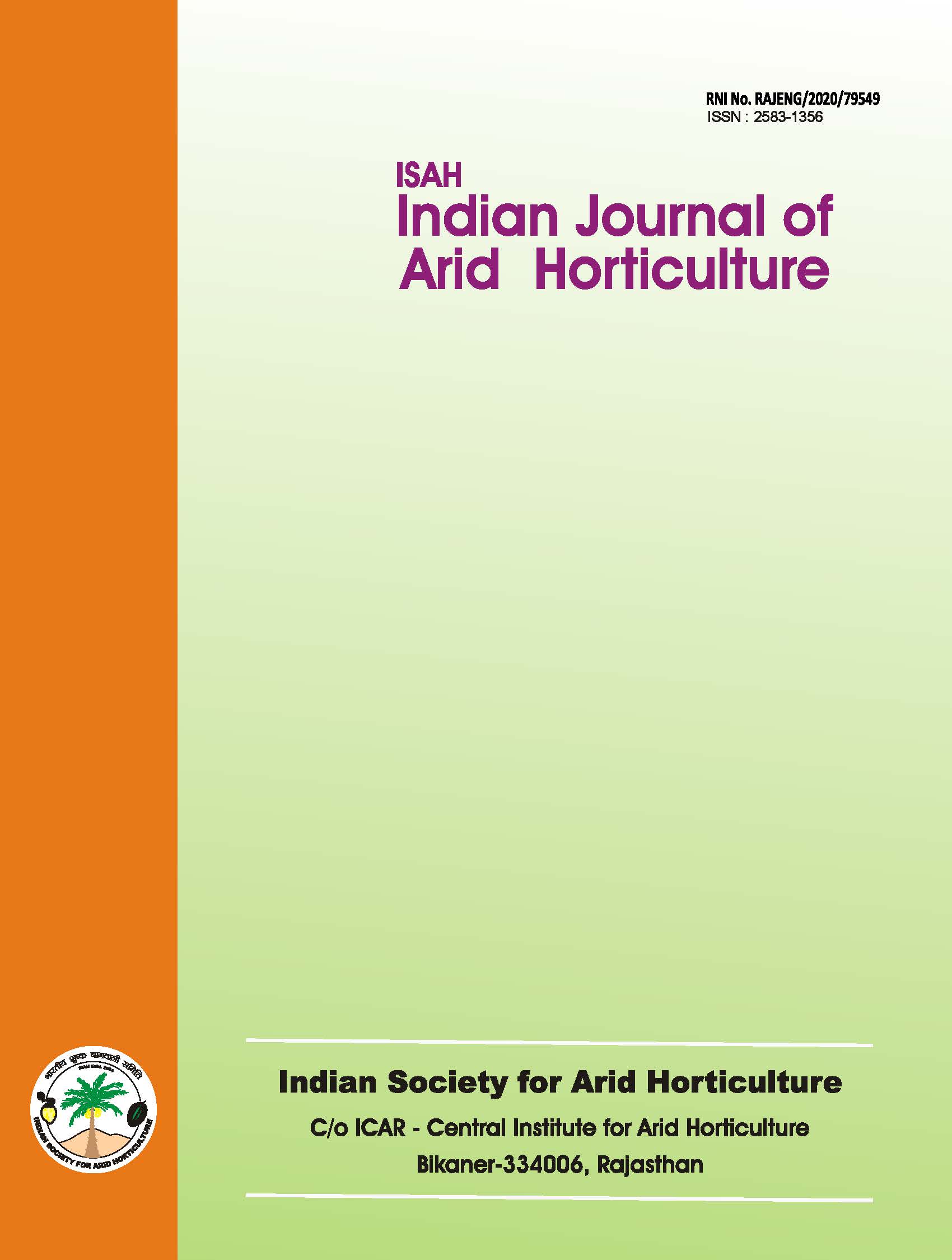Screening of Amaranths genotypes for yield and quality under hot climatic condition of semiarid ecosystem of western India.
Keywords:
Amaranthus, yield, quality, Semi arid ecosystemAbstract
An experiment on the "Screening of Amaranthus genotypes for yield and quality under semiarid condition of western India" was conducted using twenty eight accessions including released varieties were collected from diversified areas. The experiment was laid out in a randomized complete block design with three replications. The experiment results revealed that the significant differences among the genotypes for all the characters under study indicating the wide variability present in the germplasm. Among the genotypes studied in the present experiment, the highest plant height was recorded in IC-4469674 followed by IC-469676. The leaf size is considered an important character which decided by the leangth and breadth of the leaf. Arka Suguna, IC-469646, IC-469620, IC-469601 and IC-464521 recorded the lengthiest leaves over 10.0cm against IC-469645 (5.0cm). Arka Suguna, IC-469646, IC-469620 recorded the higher leaf breadth over 7.0cm against IC-469624 (2.6cm). The highest total leaf yield per plot was recorded in Arka Suguna (5.66 Kg) followed by Arka Arunima and IC-469646. This result indicate that the Arka Suguna, IC-469646, IC-469620 are broader leafy type and would be preferred by consumers. Study on quality parameters indicated that the highest protein (3.8g) and Fe (0.521mg) per 100 g has been recorded in IC-469646. Hence, Arka Suguna (Green type) and Arka Arunima (purple type) have exhibited a high yielding genotypes and IC-469646 (Green type) has registered high yield coupled with high protein and high Fe content under semiarid condition.Downloads
References
Afolabi, A. O., Oke, O. L. and Umoh, I. B. 1981. Preliminary studies on the nutritive value of some cereal-like grains. Nutr. Rpt. Intern., 24:389-394. Alfaro, M. A., Martinez, A., Ramirez, R., Bressani, R. 1987. Yiled and chemical composition of the vegetablel parts of amaranth (Amaranthus hypochondriacus L) at different physiological stage..Arch Latinoam Nutr., 37(1): 108-21. Akando, M. O. 2006. Effect of organic root plus (biostimulant) on growth, nutrient content and yield of Amaranthus. African J. of Biotech, 5(10): 871-874.
Betschart, A. A., Irving, D. W., Shepherd, A. D. and Saunders, R. M. 1981. Amaranthus cruentus: milling characteristics, distribution of nutrients within seed components, and the effects of temperature on nutritional quality. J. Food Sci., 46:1181-1187.
Bola, Oboh. 2007. Multivariate analysis of the diversity among some Nigerian Accession of Amaranthus hybridus. Intl J. of Plant Breed and Genet., 1(2): 89-94. Brenner, D. M., Baltensperger, D. D., Kulakow, P. A.,
Lehmann, J. W., Myers, R. L., Slabbert, M. M., Sleugh, B. B. 2000. Genetic resources and breeding of Amaranthus. Plant Breed. Rev., 19: 227285.
Dean, S. 1986. High-tech crop breeding may case world hunger. Agr. Inform. Development Bull. United Nations 8:19.
Katiyar, R. S., Shukla, S. and Rai, S. 2000. Varictal performance of grain Amaranthus (Amaranthus hypocandriacus) on sodic soil. Proc. Nat..Acad. Sci.India., 70(B) II. 185-187. Randle, A. B. 1959. Amaranthus; In the classification of
flowering plants. Cambridge University Press. pp. 102-105.
Shukla, Shudhir and Singh, S. P. 2000. Studies on genetic parameters in Vegetable Amaranthus (Amaranthus tricolor). J. of Genet. and Plant Breeding, 54: 133-135.
Shukla, Shudhir and Singh, S. P. 2003. Correlation and path analysis in grain Amaranthus (Amaranthus sp.). Indian J. Genet. and Plant Breeding, 63(2): 163-
164. Shukla Sudhir Bhargava Atul Chatterjee A Srivastava J and Singh SP. (2006); Genotypic variability in vegetable amaranth (Amaranthus tricolor L.) for foliage yield and its contributing traits over successive cuttings and years. Euphytica., 151(1): 103-110.
Shukla, Sudhir Bhargava, Atul Chatterjee, A., Srivastava, J. and Singh, S. P. 2004. Interrelationship among foliage yield and its contributing traits in vegetable Amaranthus (Amaranthus tricolour). Prog. Hort., 36(2): 299-305.
Shukla, Sudhir Bhargava, Atul Chatterjee, A. Srivastava, J., Singh, N. and Singh, S. P. 2006. Mineral profile and variability in vegetable amaranth (Amaranthus tricolor). Plant foods for Human Nutrition, 61(1):23-28.
Teutonics, R. A. and Knorr, D. 1985. Amaranth: composition, properties, and applications of a rediscovered food crop. Food Tech., 39:49-60. Tucker, J. B. 1986. Amaranth: the once and future crop. Bio
Science.,36:9-13.
Uzo, J. O. and Okoric, A. U. 1983..Amaranthus hybridus: a potential grain crop. Nutr. Rpt. Intern., 27:519- 524.
Varalaksmi. 2004. Characterization and preliminary evaluation of vegetable amaranthus (Amaranthus sp) germplasm, PGR News letter, 137:55-57. Xiao, S., Liu, G., Song, Y. and Yang, G. 2000. Classification of vegetable amaranthus variety resources. J. Hunan Agrl. Univ., 25:274-77. Zafar, N., Aziz, S., Mazood, S. 2006. Phenotypic divergence for some agro-morphological traits among landrace genotypes of rice (Orysa sativa.L) form Pakisthan. International J. Agric. Biol., 6:335-339.

